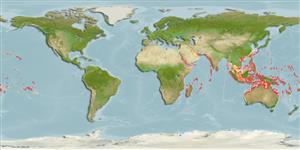>
Eupercaria/misc (Various families in series Eupercaria) >
Scaridae (Parrotfishes) > Scarinae
Etymology: Chlorurus: Greek, chloros = green + Greek oura = tail (Ref. 45335).
More on author: Forsskål.
Environment: milieu / climate zone / depth range / distribution range
Ecologia
marinhas; estuarina associadas(os) a recifes; oceanódromo (Ref. 51243); intervalo de profundidade 0 - 50 m (Ref. 5213). Tropical; 30°N - 33°S, 30°E - 130°W
Indian Ocean.
Comprimento de primeira maturação / Tamanho / Peso / Idade
Maturity: Lm 15.0 range ? - ? cm
Max length : 40.0 cm TL macho/indeterminado; (Ref. 2334)
Espinhos dorsais (total) : 9; Raios dorsais (total) : 10; Espinhos anais: 3; Raios anais : 9. Initial phase very variable in coloration. Small individuals may be uniformly dark brown to light gray with or without the dark-centered light area on the caudal peduncle; large individuals may have a series of irregular rows of small light spots posteriorly or have the dark-centered light area on the caudal peduncle. The terminal phase is also variable with or without a large tan area on the side or on the caudal peduncle. Rounded snout (Ref. 48636).
One of the most widespread parrotfishes, but highly variable and some geographical forms that are probably subspecific (Ref. 48636). Inhabit both coral rich (Ref. 58652) and open pavement areas of shallow reef flats and lagoon and seaward reefs (Ref. 5213), as well as drop-offs, behaving differently in various areas (Ref. 48636). Benthopelagic (Ref. 58302). Juveniles found in coral rubble areas of reef flats and lagoons (Ref. 9710). Juveniles and individuals in the initial phase form large groups that migrate great distances between feeding and sleeping grounds (Ref. 9710). Feed on benthic algae (Ref. 30573). Minimum depth range reported taken from Ref. 30874. Protogynous (Ref. 55080). Minimum depth from Ref. 58018.
Ciclo de vida ou comportamento de acasalamento
Maturidade | Reprodução | Desova | Ovos | Fecundidade | Larvas
Oviparous, distinct pairing during breeding (Ref. 205). Size at sex change: 35.1 - 47.2 cm TL (Ref. 55080).
Eschmeyer, W.N., 1997. PISCES. Eschmeyer's PISCES database as published on the Internet in June 1997, URL: gopher://gopher.calacademy.org:640/7. (Ref. 12965)
Status na Lista Vermelha da UICN (Ref. 130435: Version 2024-1)
Ameaça para os humanos
Reports of ciguatera poisoning (Ref. 31637)
Uso pelos humanos
Pescarias: espécies comerciais; Aquário: Espécies comerciais
Ferramentas
Can't connect to MySQL database fbquizv2. Errorcode: Too many connections
